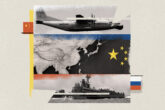July 09, 2019
A Bold Idea for Security Reform in the Indo-Pacific Region
Former Acting Secretary of Defense Patrick Shanahan’s recent speech at the Shangri-La Dialogue was expected to herald a new approach to the Indo-Pacific region by the United States. But the speech, and the subsequent release of a new Indo-Pacific strategy by the Department of Defense, did not announce any bold new initiatives nor offer specifics about operationalizing America’s Free and Open Indo-Pacific (FOIP). This is unfortunate and represents a missed opportunity. Although America has promoted FOIP and ramped up its Freedom of Navigation Operations(FONOPs) program in the South and East China Seas during the past year, it needs to do more to demonstrate its long term commitment to the Indo-Pacific region to its allies and partners. One way it could do this is by establishing a multi-national Standing Indo-Pacific Maritime Group (SIPMG).
A standing maritime task force of this kind, based on the Standing NATO Maritime Groups (SNMGs), has been proposed for the Pacific theater many times. Unfortunately, the lack of an alliance organization equivalent to NATO in the Indo-Pacific has prevented the easy replication of such a group. Yet a fifty-year old report from the Naval War College provides a blueprint for establishing such a force. By leveraging its treaty alliances in the Pacific, America could establish a SIPMG in coalition with Japan, Australia, South Korea, the Philippines and/or Thailand. Then, applying an open architecture concept, participation could be expanded to include any nation that supports FOIP and can provide forces. Britain, France, India and Canada would all be prime candidates to join the group.
An open-ended SIPMG would provide a flexible option for nations to demonstrate their support of the rules-based international order. Participation would not require a formal treaty alliance nor require a long-term allocation of assets. Working together to coordinate ship deployments, participating nations could ensure a combination of destroyers, frigates, amphibs and replenishment ships—between four and eight total—are maintained. Using a variable mix of ships would increase the ability of nations to contribute forces. It would also prevent any single nation from stretching its capacity to the breaking point and provide a more cost-effective alternative for those looking to maintain a steady-state naval presence in the Indo-Pacific. Rather than supporting costly deployments of individual task groups, nations participating in the SIPMG would share operational costs. And just like the SNMGs, command of the SIPMG could rotate periodically between participating nations, which would demonstrate the collaborative nature of the group.
Read the full article in The National Interest.
More from CNAS
-
On Alliances in Northeast Asia
For the U.S. alliances with South Korea and Japan to thrive — or merely survive — under the next administration, policy makers need to consider different options for different...
By Dr. Duyeon Kim
-
The China-Russia Entente in East Asia
Executive Summary Closer cooperation between China and Russia is a major force driving global geopolitics. But how relations between the two authoritarian powers are shaping s...
By Jacob Stokes, Evan Wright & Nathaniel Schochet
-
Addressing a Human Rights and Looming Terrorism Crisis in Afghanistan
Pursuing the same harsh policies as it did during its previous stint in power in the 1990s, the Taliban has increasingly clamped down on the rights of women and girls since re...
By Lisa Curtis & Annie Pforzheimer
-
Forging a New Era of U.S.-Japan-South Korea Trilateral Cooperation
Executive Summary In August 2023, the leaders of Japan, the Republic of Korea (ROK), and the United States met for an unprecedented in-person summit at Camp David to expand an...
By Lisa Curtis, Evan Wright & Hannah Kelley




